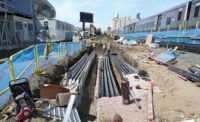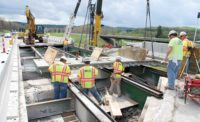Few projects last more than 40 years, but the New York City Department of Environmental Protection�s $6 billion, 60-mi City Water Tunnel No. 3, the largest project in the city�s history, has spanned more than four decades, with one segment open, another under way and several more elements in the works as the department aims for a 2020 completion.
�Manhattan has been served by City Water Tunnel No. 1, constructed in 1917, and in order to take that tunnel down to do repairs and replace aging piping, we needed another tunnel,� says Kathryn Mallon, deputy commissioner of the DEP�s bureau of engineering, design and construction. �It provides critical reliability and redundancy.�
The city system delivers more than 1 billion gallons a day to residents of New York and four surrounding counties. New York City�s water originates as far as 125 miles north and west of the city in the Croton, Delaware and Catskill watersheds. That water comes together at the Hillview Reservoir in Yonkers and flows primarily by gravity into the City Water Tunnels.
Although the Water Tunnel No. 3 project began in 1970, funding was not always available to support the project, Mallon says. However, Mayor Michael Bloomberg�s administration has committed more than $2.5 billion since 2002 to complete the tunnel, which was designed in-house by DEP engineers.
�It is interesting to be so far below ground unbeknownst to the people above,� Mallon says. �The tunnel goes through solid rock and was well designed. There weren�t any surprises.�
Manhattan Milestone
Water Tunnel No. 3 reached a milestone in May when the joint venture team of Schiavone Construction Co. of Secaucus, N.J.; J. F. Shea Construction of Walnut, Calif.; and Frontier-Kemper Constructors of Pelham, N.Y., completed boring a $680 million, 12.5-ft tunnel at an average depth of 550 ft below ground through the bedrock, installing 8.5 mi of concrete liner, and building nine shafts that will bring water to the surface.
Schiavone/Shea/Frontier-Kemper built the shafts from the ground down, drilling, blasting and excavating the resulting rock material, adding supports and then repeating the process at a deeper level until reaching the desired length. The team froze the ground at each shaft to act as a top support.
�When you are that deep any little thing can go wrong, so building those shafts was a difficult part of the work,� says Paul Scagnelli, executive vice president and chief engineer at Schiavone.
Work on the Manhattan section of the tunnel began in 2002. It originates on the far West Side. One 3.5-mi leg runs south to lower Manhattan, another 2.5-mi leg advances north to Central Park, and a cross-town leg runs east and then turns north.
�With the tunnel-boring machine, we mined through a major fault where we had some ground loss, but we were able to keep the workers safe,� Scagnelli says. The team installed temporary blocking through the fault and later added concrete. �When you have a fault at that depth, you cannot reach it from the surface,� he adds.
The lining required pumping the concrete as much as 7,000 ft horizontally, Scagnelli says.
DEP awarded the next $176 million Manhattan-phase to a joint venture among John P. Picone of Lawrence, N.Y.; Schiavone; Frontier-Kemper; and Dragados USA of New York. The work includes building 10 shafts; installing 24-in, 36-in and 48-in diameter pipes; refurbishing butterfly valves; and placing those valves in riser chambers that will take the water to the surface. The team will also install electronic controls in the chambers.
What�s Ahead
DEP expects the Manhattan section of the tunnel to be operational in 2013. After that, finishing an 11-mi section of Water Tunnel No. 3 in Brooklyn and Queens takes top priority. It will create redundancy for Water Tunnel No. 2, which was built in the 1930s. The tunnel was completed, using a tunnel-boring machine, in 2001. In addition, five of seven shafts are finished, completed by a variety of contractors. Two more shafts will be constructed in the next few years.
Once the Queens project is complete, Mallon says, DEP plans to take the existing tunnels out of service to complete a full investigation of their status and will decided how to proceed with any necessary repairs. Neither tunnel has been inspected or repaired since the city put them in service.
Additional work is planned, such as a 16-mi section of Water Tunnel No. 3, from the Kensico Reservoir to the Van Cortlandt Valve Chamber in the Bronx, and a tunnel from the Value Chamber to the eastern parts of the Bronx and Queens. These segments remain in the planning stage.
Looking Back
City officials conceived the new Water Tunnel No. 3 in the 1950s and developed in 1966 with an expected cost of $718 million, according to a 2001 audit report from the New York City Comptroller.
Water Tunnel Contractors, a consortium consisting of the Walsh Construction Co. of Chicago; Dravo Corp. of Pittsburgh, Pa.; S.J. Groves and Sons Co. of Minneapolis; the Arundel Corp. of Sparks, Md.; the L.E. Dixon Co. of San Gabriel, Calif.; and the Ostrander Construction Co. of Portland, Ore., began construction on the first $1 billion, 13-mi section of Water Tunnel No. 3 in 1970, and completed it 23 years later, 16 years longer than first anticipated. The rate of construction was less than one mile per year, far below the rates of 3.02 mi per year for tunnel No. 1 and 2.49 mi per year for tunnel No. 2. The audit explains that contract disputes and the city�s fiscal crisis contributed to the delays. The prolonged schedule increased the project�s cost.
That first section of tunnel began supplying water from the Hillview Reservoir, 450 to 800 feet below the surface, through the Bronx to Roosevelt Island in 1998.
�Stage one was slower,� says Burjor Kharivala, chief water works designer for DEP. �There was no tunnel-boring machine. It was drill and blast. The technology has changed over the years.�
Stage two also has taken longer to build than anticipated. Schiavone-Shea Construction, a joint venture between Schiavone Construction and J. F. Shea Construction, completed the first leg in 1999. Grow-Perini-Skanska, a joint venture between Grow Tunneling Corp. (now Kiewit Corp.) of New York, Perini Corp. (now Tutor Perini) of Sylmar, Calif., and Skanska USA Civil Northeast, Whitestone, N.Y., was responsible for the second leg. Stage two, according to the audit, had an anticipated completion date of 2006. Two of the Brooklyn/Queens shafts are still in design, with work expected to begin in the next few years.






Post a comment to this article
Report Abusive Comment